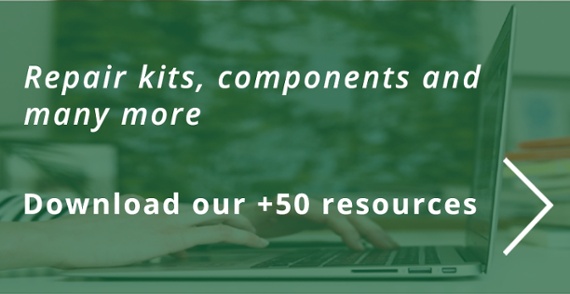
Within the motion transmission system, the clutch mechanism is responsible for allowing or interrupting the passage of mechanical power from the engine to the gearbox; either at the driver’s will (manual clutches) or automatically (automatic clutches). This function is essential in order to be able to disengage the engine and operate the gearbox so that the engine speed at which the engine is working is optimal at all times.
Clutch systems are usually parts that stand the test of time very well, so it is not very common to repair them. However, if our car is used to driving many kilometres in the city (with many more starts and stops) the repair will be necessary in a shorter period of time.
If you think you need to repair your car’s clutch, in this Frenkit post we give you the steps you need to follow and what tools to use to do it.
When to change the vehicle clutch
As mentioned above, the clutch system does not break down very often. The service life of the clutch varies depending on the car model and also on the individual driving style.
It is impossible to know how often we should repair the clutch of our car. It can be more than 150,000 kilometres; although it is likely that at some point in the past, the system may need to change at least some of its elements.
Among the most common clutch failures are; wear or breakage of the clutch disc lining, possible deformation of the clutch housing, defects in the dual mass flywheels or the hydraulic system, or jamming of the thrust collar, among others.
Some of the signs that may indicate that the clutch needs to be repaired are:
- The vehicle has a high fuel consumption.
- When we smell burning while using the clutch.
- The clutch jerks, causing vibrations.
- Clutch hardness.
- We hear a loud noise when the clutch is released.
- The engine loses power.
- Speeds “scrape” on insertion.
Tools you need to repair the clutch
Before knowing the steps to follow to repair the clutch of the vehicle, we must know what tools we will need for its repair:
- Hydraulic jack or hoist. We will use it to lift the car and carry out the repair and clutch replacement.
- Support columns. They are used to raise the car so that we can work more easily.
- Tool box. Where you will find everything you need to repair the clutch: ratchet spanner, gloves, screwdrivers, cross spanner, etc.
- Fine sandpaper. We will use it to remove rust from the flywheel.
- Centring device. Used to ensure correct alignment of the clutch to the crankshaft hub.

How long does it take to repair a clutch
At Frenkit we remind you that this is a complicated repair, only suitable for people with knowledge of mechanics or professionals in the sector. If you are not one of them, the best thing to do is to go to a reliable workshop.
Now, here are the steps to follow to repair your vehicle’s clutch system correctly:
Put the car in the right position and lift it up
The first step is to find out, in a simple way, if the clutch still has power. To do this, place the car on a flat surface, switch off the engine and activate the handbrake. Release the clutch and start the engine at idling speed. Then, engage a high gear. The engine should shut off when accelerating. If this does not happen, then the car must be lifted with a hydraulic jack to change the clutch.
Disconnecting the battery
Although the clutch assembly is a purely mechanical element, to access it, we will have to disconnect different modules and sensors, so it is advisable to disconnect the battery before starting the process. To do this, we will open the bonnet of the car and remove the negative terminal, the black one, and then the positive one, the red one.
Removing the gearbox
Before we can remove the defective clutch system, we will need to make our way to it, and for this, we must first disassemble the gearbox by carrying out all the necessary operations to do so. It is necessary to check in each case the arrangement or geometry of the gearbox of your vehicle for its correct disassemble (it is possible that we will have to drain the oil from the gearbox, so we will take advantage of this to change it by refilling it with new oil in the subsequent assembly process).
Apply grease to components
Next, we are going to tune the clutch of our vehicle, for this we will apply grease on the inner part of the collar and on the contact surfaces with the clutch fork. Do not forget to apply grease to the friction and friction points of the fork.
Preparing the clutch for installation
In this step it is important to carry out the following operations one by one and in order. To begin with, we will place the clutch kit on the flywheel, using the centring pins. Then, we will proceed to tighten three of the clutch housing bolts. It is essential that at this point we check that the clutch disc is stable and centered.
Also make sure that the centring pin goes in and out of the disc without the need to use force.
Next, tighten the housing screws (remember to respect the star tightening sequence). At this stage, the fingers of the diaphragm must move evenly, in order to remain in a horizontal position and after having repeated the tightening sequence at least three times.
The last step is to place the collar on the guide tube and check that it moves smoothly.

Replace the gearbox
It’s time to mount the gearbox! First of all, we will review all the cases that, from Frenkit, we give you bellow:
- The first thing to do is to make sure that the centring sleeves, located between the engine and the gearbox, are in perfect condition.
- We will proceed to mount the gearbox, supporting its weight on a hydraulic jack. The weight must not be supported by the clutch disc hub.
- Now, insert the gearbox shaft into the spline of the clutch disc hub. Care must be taken here, as the primary shaft of the gearbox must not collide with the clutch disc hub. If necessary, the crankshaft can be rotated to make assembly easier.
- At the same time, check that the gearbox is aligned with the engine block and that the guide bushes are securely fastened. Tighten the bolts securing the engine to the gearbox using a torque wrench.
Start the engine and check the clutch
Now we come to the last step. Once all the parts are in place, we proceed to check the clutch is working as it should. Some of the potins that we have to check that they are correct are: the gear shift and reverse gear or that there are no abnormal noises, for example. If the car is at a standstill, and the travel is normal, fit the wheels and you are done.
At Frenkit sowe are specialists in clutch systems for a wide range of vehicles. Visit our website and discover our extensive catalogue with a wide range of repair kits.


